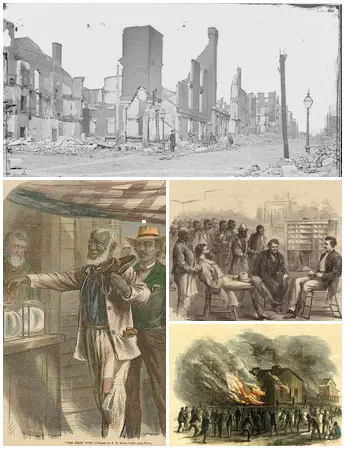The Devastation of the South
The Civil War left an indelible mark in the minds of the Southern Americans as it burned down their plantations and farms and destroyed its crops. Before the war, the South had 297 towns and cities with a total population of 835,000, which included several Union forces members.
Facts about the Devastation of the South
- The rebuilding of the South after the Civil War is known as the reconstruction period. It started in 1863 and lasted until 1877.
- The primary purpose of reconstruction was to assist the South to become a part of the Union again.
- More than a fourth of Southern white men of the military died in the war, leaving several families destitute. This resulted in a decline of the per-capita income for White Southerners from $125 in 1857 to $80 in 1879.
- Federal troops surrounded a considerable portion of the South in the reconstruction period to prevent any uprising and ensure that all rules are followed.
- The three visions of the Civil War which appeared in reconstruction included the white supremacist vision, the reconciliations vision, and the emancipationist vision.
- The South was locked into a system of poverty by the end of the 19th century and until the start of the 20th century.
- The railroad in Atlanta, which was destroyed during the Civil War, went bankrupt five times in its rebuild attempts before it was bought by the Southern railroad.
- The South was the wealthiest part of the nation and had the highest number of college graduates before the war.
Effects of the War
Unfortunately, 11 cities were destroyed and suffered massive damages during the Civil War. These cities included Richmond, Virginia, Charleston, South Carolina, Atlanta, Georgia, and Columbia, South Carolina. According to an 1860 census, these cities were home to 115,900 individuals or 14 percent of the entire population of the urban South.
Statistics further added that the number of individuals who lived in destroyed places accounted for only one percent of the combined rural and urban populations of the Confederacy. The Civil War also depleted the pre-war stock of cattle, mules, and horses with roughly two-fifths of the livestock in the South found dead.
While the farms in the South were not mechanized, the 1860 census revealed that the value of machinery and farm implements destroyed during the war amounted to $81 million. The limited availability of riverboat services and railroads also hindered the distribution of animals and crops to the market.
The cost of the Civil War
The high cost of the Civil War effort took a massive toll on the economic infrastructure of the South as well. Numbers show that the direct costs to the Confederacy in physical destruction, government expenditures, and human capital were around $3.3 billion. On top of that, the Confederate dollar was of no value because of the massive inflation rate.
White planters also had little capital to pay workers to bring in crops after they lost their massive investment in slaves. This resulted in the development of a system of sharecropping wherein landowners broke up vast plantations and rented small lots to the freedmen and their families.
The end of the Civil War also resulted in a significant migration of newly freed individuals to the cities wherein African-Americans were assigned to the lowest-paying jobs like service and unskilled labors. African-American men worked as hotel workers, lumber and rolling mills workers, and rail workers. Black women were confined to domestic work and were employed as child nurses, maids, cooks, and laundresses.
How long did reconstruction last?
Reconstruction started in 1863 and ended in 1877.

What are the three visions of the Civil War that appeared in the reconstruction?
The three visions of the Civil War that appeared in reconstruction were the white supremacist vision, the reconcialitionist vision, and the emancipationist vision.
How many Southern cities were destroyed or severely damaged during the Civil War?
Approximately 11 Southern cities were destroyed or severely damaged in the Civil War.
What was the per-capita income of White Southerners in 1879?
The per-capita income of White Southerners in 1879 was $80.
What was the purpose of reconstruction?
The purpose of reconstruction was to help the South become a part of the Union again.



